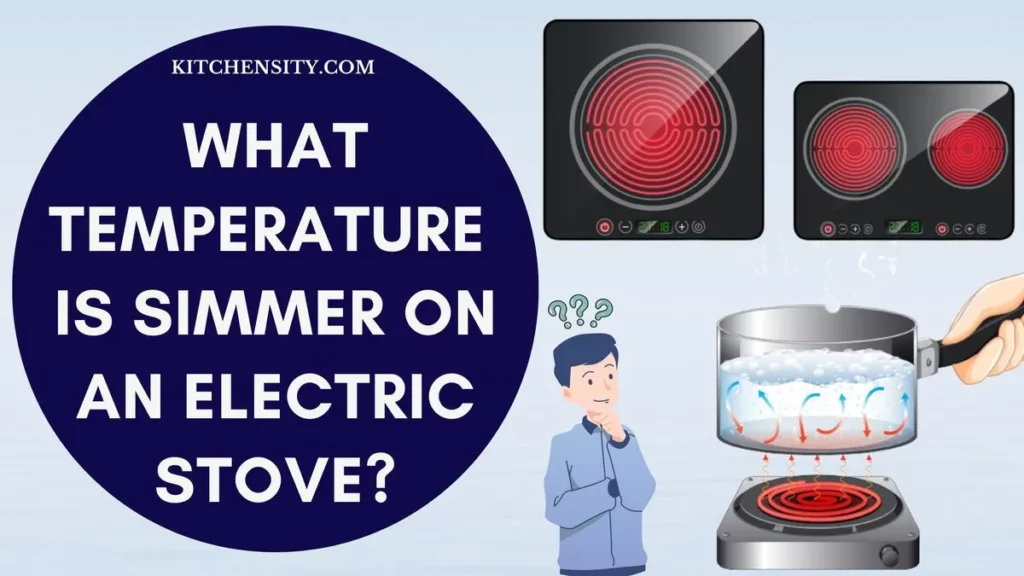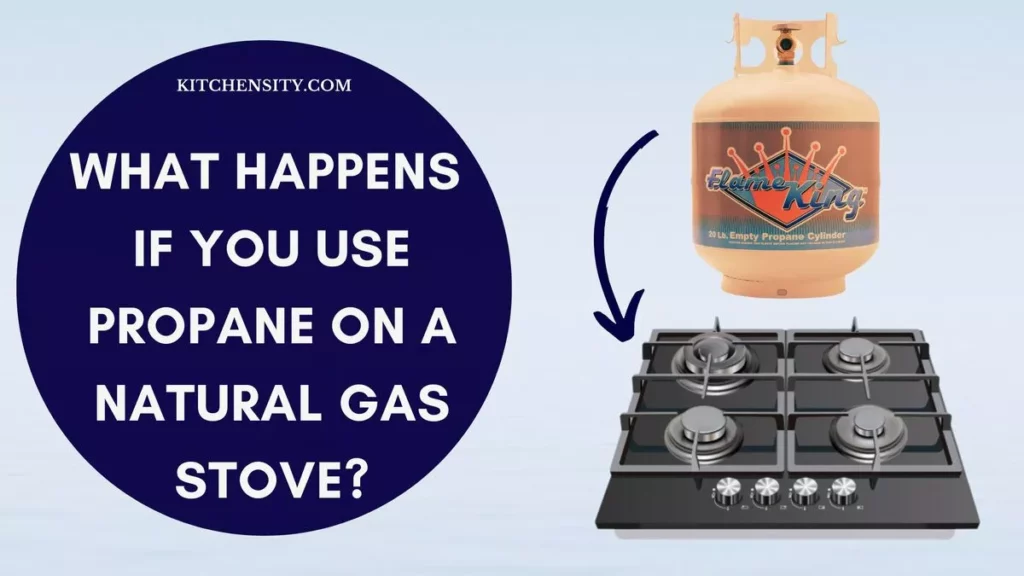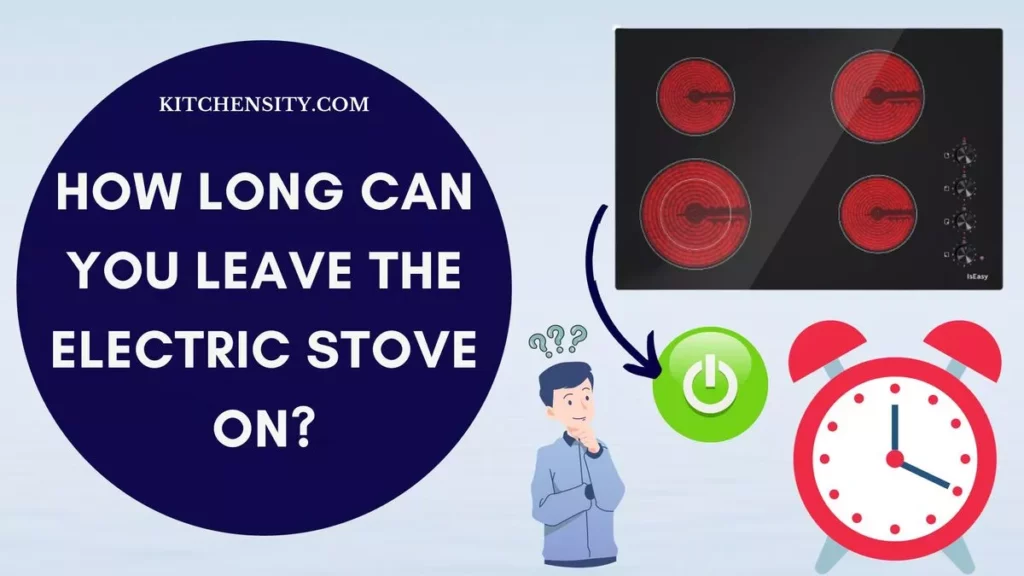When you turn the knob on your gas stove and expect that reassuring whoosh of a lit burner, but all you get is the pungent smell of gas, it can be both frustrating and concerning.
In this article, we will explore the common reasons why your gas stove won’t light but emits a gas odor.
We’ll delve into the potential causes and provide practical solutions to ensure your safety and convenience in the kitchen.
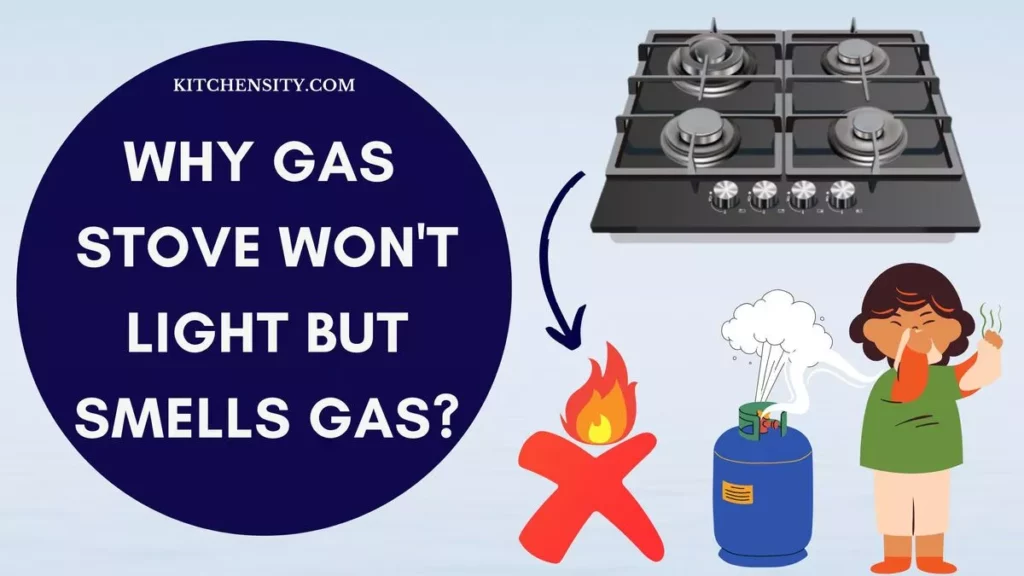
Table of Contents
- 1 Why Gas Stove Won’t Light But Smells Gas?
- 2 Understanding The Basics
- 3 Common Reasons For Gas Stove Won’t Light But Smells Gas
- 4 How To Fix Gas Stove That Smells Of Gas But Won’t Light?
- 5 Is It Normal To Smell Gas From Stove?
- 6 Troubleshooting And Solutions
- 7 Safety Measures When Dealing With A Gas Stove Not Lighting
- 8 Prevention Tips To Avoid Gas Stove Not Lighting
- 9 Final Verdict On Why Gas Stove Won’t Light But Smells Gas?
- 10 FAQs (Frequently Asked Questions)
- 10.1 Why Can I Smell Gas But My Stove Is Not Lighting?
- 10.2 Is It Dangerous If My Gas Stove Smells Like Gas But Won’t Light?
- 10.3 Can I Clean My Gas Stove Burners With Household Cleaning Products?
- 10.4 How Often Should I Clean My Gas Stove Burners?
- 10.5 What Should I Do If I Can’t Reset The Safety Mechanism On My Gas Stove?
- 10.6 Are There Any Preventive Measures To Avoid Gas Stove Issues?
Why Gas Stove Won’t Light But Smells Gas?
A gas stove emitting the smell of gas but not lighting is a cause for concern and not normal. This issue typically results from problems such as gas supply issues, dirty or clogged burners, faulty igniters, or triggered safety mechanisms.
Immediate action is necessary, including ventilation, shutting off the gas supply, and seeking professional assistance to resolve the problem and ensure safety.
Also Read – What Happens If You Use Propane On A Natural Gas Stove?
Understanding The Basics
Before we delve into troubleshooting why your gas stove won’t light but emits a gas odor, it’s essential to grasp the fundamental workings of a gas stove.
The Anatomy Of A Gas Stove
A gas stove comprises several key components that work together to provide a controlled flame for cooking:
- Burners: These are the round or square grates on top of your stove where the flames appear. Burners are where you place your pots and pans for cooking.
- Igniters: Each burner typically has an igniter, a small device that creates a spark to ignite the gas. This spark is what starts the flame when you turn the stove knob.
- Gas Lines: Gas stoves are connected to a supply of natural gas or propane through a network of gas lines. These lines transport the gas to the burners when you turn them on.
- Safety Mechanisms: Modern gas stoves are equipped with various safety features that automatically shut off the gas supply if they detect issues like a flame going out or a gas leak. These mechanisms are crucial for your safety.
The Role Of The Igniter
The igniter is a pivotal component of your gas stove, responsible for lighting the gas when you want to cook. When you turn the knob to activate a burner, the igniter generates a spark. This spark ignites the gas, creating the flame you need for cooking.
Understanding these basic components and how they work together is the first step in diagnosing and solving the issue of a gas stove that won’t light but smells of gas.
Also Read – Master Medium Heat On A Stove
Common Reasons For Gas Stove Won’t Light But Smells Gas
There are several potential causes for this issue, and understanding them can help you address the problem effectively:
1. Gas Supply Issues
- Gas Leaks: A gas leak in the gas line or a loose connection can lead to the smell of gas. If the gas is leaking before it reaches the burners, it won’t ignite, resulting in a non-lit stove.
- Gas Valve Not Fully Open: Sometimes, the gas valve leading to the stove may not be fully open. This partial flow of gas can create a gas odor without providing enough gas to ignite the burners.
2. Dirty Or Clogged Burners
- Accumulated Debris: Over time, burners can accumulate dirt, food particles, and grease. These contaminants can obstruct the flow of gas, preventing the burners from lighting properly.
- Blocked Igniter: If the igniter itself is clogged or covered in grime, it may not generate a spark strong enough to ignite the gas. This can lead to a gas smell without ignition.
3. Faulty Igniter
- Damaged Igniter: If the igniter is malfunctioning, damaged, or worn out, it won’t create the necessary spark to light the gas. This can result in a gas odor without a flame.
- Disconnected Igniter Wiring: In some cases, the wiring connecting the igniter to the stove’s control panel may become loose or disconnected. This can prevent the igniter from functioning correctly.
4. Safety Mechanisms
- Safety Features Activation: Modern gas stoves are equipped with safety mechanisms that detect issues like a flame going out or a gas leak. When these safety features are activated, they can prevent the stove from lighting to avoid potential hazards.
5. Other Issues
- Gas Pressure Problems: Issues with the overall gas pressure in your home can also affect the stove’s ability to light. Low gas pressure may not provide enough fuel for ignition.
- Electronic Control Board Malfunction: In some cases, the electronic control board of the stove may malfunction, preventing it from sending the necessary signals to the igniter.
- Gas Regulator Problems: The gas regulator, which controls the flow of gas to the stove, can sometimes malfunction, affecting the stove’s ability to light.
Understanding these common reasons for a gas stove not lighting but emitting a gas odor is the first step in troubleshooting and resolving the issue.
Depending on the specific cause, you may need to perform some maintenance or seek professional assistance to ensure the safe and proper functioning of your gas stove.
Also Read – Should A Slow Cooker Simmer On Low?
How To Fix Gas Stove That Smells Of Gas But Won’t Light?
Dealing with a gas stove that emits a gas odor but refuses to light can be concerning, but you can often resolve the issue with some troubleshooting and basic maintenance. Here’s a step-by-step guide to help you fix the problem:
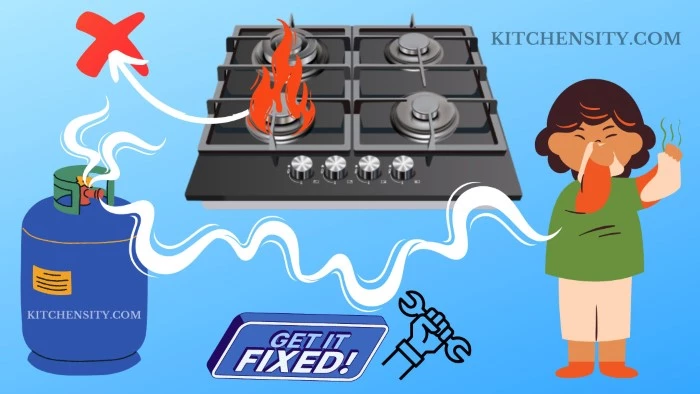
1. Safety First
Before attempting any troubleshooting or fixes, prioritize safety:
- Ventilate The Area: Open windows and doors to allow proper ventilation and ensure that any accumulated gas disperses safely.
- Turn Off Gas Supply: Locate the main gas shut-off valve, usually located near the gas meter, and turn it off to prevent further gas flow to the stove.
- No Open Flames: Avoid using any open flames, including matches, lighters, or candles, in the area until the issue is resolved.
2. Inspect For Gas Leaks
Carefully inspect the gas stove and surrounding areas for gas leaks:
- Check Gas Connections: Examine the gas supply line, connections, and fittings leading to the stove for any visible signs of damage or leaks. If you notice a leak, do not proceed further; contact a professional technician immediately.
3. Clean The Burners
Dirty or clogged burners can obstruct the flow of gas. Cleaning them can often resolve the issue:
- Turn Off The gas: Ensure the gas supply to the stove is turned off.
- Remove Burners: Carefully remove the burners from the stove. Refer to your stove’s manual for guidance on how to do this.
- Clean Thoroughly: Use a soft brush, mild dish soap, and warm water to clean the burners. Pay close attention to removing any grease, food debris, or dirt. Rinse them thoroughly and let them dry completely.
4. Inspect And Clean The Igniter
The igniter is critical for sparking the flame. Ensure it’s clean and functioning correctly:
- Examine The Igniter: Inspect the igniter for any visible damage, dirt, or debris. Clean it gently using a soft brush or cloth to remove obstructions.
- Proper Alignment: Make sure the igniter is correctly aligned with the burner.
5. Reset Safety Mechanisms
Modern gas stoves come with safety mechanisms. If one has been triggered, resetting it can help:
- Turn Off The Gas: Turn off the gas supply to the stove.
- Wait And Reset: Wait for a few minutes to allow the safety features to reset. Then, turn the gas supply back on.
6. Check Gas Pressure
Ensure that your home’s gas pressure is within the recommended range for your stove. Low gas pressure can affect ignition:
- Contact Gas Provider: If you suspect an issue with gas pressure, contact your gas provider to check and adjust it if necessary.
7. Professional Assistance
If the issue persists after performing these troubleshooting steps, or if you are uncomfortable with any part of the process, it’s essential to seek professional assistance from a qualified technician who specializes in gas appliances.
Remember, safety is paramount when dealing with gas-related issues. Always err on the side of caution, and if you smell gas and suspect a leak, evacuate the area and contact emergency services and a professional technician immediately.
Also Read – Is Simmer Lower Than Low?
Is It Normal To Smell Gas From Stove?
No, it is not normal to smell gas from a stove under normal operating conditions. Natural gas, which is commonly used as a fuel for stoves, is odorless and colorless.
However, for safety reasons, an odorant called mercaptan is added to natural gas to give it a distinctive and unpleasant smell, often described as similar to rotten eggs.
This odor is added specifically to alert people to the presence of gas leaks, as natural gas is highly flammable and poses a safety hazard if it escapes into the air.
If you smell gas coming from your stove or anywhere in your home, it is a cause for concern and should be addressed immediately:
- Ventilate The Area: Open windows and doors to allow fresh air to circulate and help disperse the gas.
- Turn Off The Gas Supply: Locate and shut off the gas supply valve leading to the stove. If you are unsure about the valve’s location, turn off the main gas supply valve in your home.
- Do Not Use Open Flames Or Ignition Sources: Do not light matches, use lighters, or operate any electrical switches, as sparks can ignite the gas.
- Evacuate The Area: If the gas smell is strong and pervasive, evacuate your home immediately. Leave doors open to allow gas to escape.
- Contact Emergency Services: Call emergency services (e.g., 911) to report the gas smell and follow their instructions. Also, contact your gas provider to report the issue and seek their assistance in resolving the gas leak.
Also Read – How To Simmer On An Electric Stove?
Troubleshooting And Solutions
If your gas stove won’t light but you can smell gas, it’s important to address the issue promptly and safely. Here are some troubleshooting steps and solutions to help you resolve the problem:
1. Gas Supply Troubleshooting
- Check for Gas Leaks: Start by inspecting the gas supply line for any visible signs of leaks. If you notice a gas odor and suspect a leak, it’s crucial to act quickly. Turn off the gas supply at the main valve and contact a professional technician to assess and repair the leak.
- Verify Gas Valve Position: Ensure that the gas valve leading to the stove is fully open. Sometimes, the valve may be partially closed, restricting the flow of gas. Turn it fully counterclockwise to open it.
2. Cleaning Burners
- Regularly cleaning your burners can prevent clogs and ensure a consistent gas flow.
- Turn off the gas supply, remove the burners, and clean them thoroughly.
- Use a mixture of mild dish soap and water to remove grease and debris.
- Rinse them well and ensure they are completely dry before reassembling.
3. Igniter Inspection And Replacement
- Check the Igniter: Examine the igniter for any visible damage, dirt, or debris. Clean it carefully using a soft brush or cloth to remove any obstructions that may hinder the spark. Ensure that the igniter is properly aligned with the burner.
- Test the Igniter: Turn on a burner and observe the igniter. If you don’t see a visible spark or hear a clicking sound, the igniter may need replacement. Consult your stove’s manual for guidance on how to replace it or consider seeking professional assistance.
4. Resetting Safety Mechanisms
- If one of the safety mechanisms has been triggered, it can prevent your stove from lighting.
- To reset these safety features, turn off the gas supply to the stove, wait for a few minutes, and then turn it back on.
- Refer to your stove’s manual for specific instructions on resetting safety mechanisms.
5. Other Considerations
- Gas Pressure: Ensure that your home’s gas pressure is within the recommended range for your gas stove. Low gas pressure can affect the stove’s ability to ignite properly. Contact your gas provider to check and adjust the pressure if necessary.
- Electronic Control Board: If you suspect an issue with the electronic control board, consult your stove’s manual for troubleshooting tips. In some cases, you may need to replace the control board or seek professional assistance.
- Gas Regulator Inspection: The gas regulator, which controls the gas flow to the stove, should be inspected for proper functioning. If it’s malfunctioning, it may need replacement.
Also Read – What Temperature Is Simmer On An Electric Stove?
Safety Measures When Dealing With A Gas Stove Not Lighting
Handling a gas stove that doesn’t light but emits a gas odor requires utmost caution. Here are important safety measures to ensure your well-being:
- Ventilation Is Key: Ensure adequate ventilation in the kitchen by opening windows and doors. Proper airflow helps dissipate any lingering gas fumes.
- Turn Off All Flames And Ignition Sources:
- Immediately extinguish all open flames, including candles, cigarettes, and pilot lights on other appliances.
- Do not use any electrical switches, lighters, or appliances in the area, as sparks could ignite the gas.
- Shut Off The Gas Supply:
- Locate the gas shut-off valve near the stove or the main gas supply valve in your home.
- Turn the valve off to stop the flow of gas to the non-functioning stove. If you’re unsure about the valve’s location, contact your gas provider for guidance.
- Do Not Attempt Repairs: Never attempt to repair a gas stove yourself if you suspect a gas leak. Gas appliances require professional servicing.
- Use A Gas Detector: Consider having a gas detector installed in your kitchen. These devices can alert you to gas leaks even before you can smell them.
- Gas Leak Detection Solution: Keep a gas leak detection solution or a mixture of water and dish soap in a spray bottle handy for checking gas connections and fittings.
- Wear Safety Gear: If available, wear gloves and safety goggles as a precaution while dealing with gas-related issues.
- Evacuation:
- If you smell gas strongly and suspect a leak, evacuate your home immediately.
- Leave doors open behind you to allow gas to escape.
- Do not use your phone or any electronic device inside your home; use a neighbor’s phone or a cell phone at a safe distance to call emergency services and your gas provider.
- Professional Assistance: If your gas stove continues to emit a gas odor without lighting, contact a qualified gas appliance technician or your gas provider. Do not use the stove until it has been repaired.
- Regular Maintenance: Schedule regular maintenance for your gas appliances, including the stove. Professionals can inspect and maintain your appliances to prevent issues like gas leaks.
- Carbon Monoxide Detectors: Install carbon monoxide detectors in your home, especially near the kitchen. Carbon monoxide is a byproduct of incomplete combustion and can be harmful when gas appliances are not functioning correctly.
- Educate Your Household: Ensure that all members of your household are aware of the gas safety measures and know how to respond in case of a gas leak.
Remember, gas-related issues can be dangerous, and your safety should always be the top priority. If you ever suspect a gas leak or have concerns about your gas stove, it’s best to seek professional assistance and follow these safety measures to protect yourself and your home.
Also Read – What Does Simmer Look Like?
Prevention Tips To Avoid Gas Stove Not Lighting
- Regular Cleaning: Clean your gas stove burners and grates regularly. Remove any food debris, grease, and spills as they can clog burners and hinder ignition.
- Proper Ventilation: Ensure your kitchen is well-ventilated when cooking. Use exhaust fans or open windows to disperse any gas or cooking odors.
- Inspect Gas Lines: Periodically inspect the gas supply lines and connections leading to your stove for any signs of wear, damage, or leaks. If you notice an issue, contact a professional technician for repairs.
- Check Igniters: Test the igniters on your stove regularly to ensure they are working correctly. Replace faulty igniters promptly to avoid ignition problems.
- Avoid Spills: Be cautious when cooking to prevent spills and overflows. Clean up any spills immediately, especially around the burner area.
- Use Proper Cookware: Ensure that the cookware you use on the gas stove is flat and stable. Uneven or warped pots and pans can disrupt the gas flow and ignition.
- Read The Manual: Familiarize yourself with your gas stove’s manual and follow the manufacturer’s guidelines for operation, maintenance, and safety.
- Schedule Professional Maintenance: Arrange for regular maintenance and inspections of your gas stove by a qualified technician. They can identify and address potential issues before they become major problems.
- Avoid Using Excessive Force: When lighting your stove manually, do not use excessive force on the control knobs or switches. Gentle and even pressure is usually sufficient.
- Check Gas Pressure: Periodically have your gas provider check the gas pressure to ensure it meets the requirements for your gas stove.
Final Verdict On Why Gas Stove Won’t Light But Smells Gas?
So, the issue of a gas stove that won’t light but emits a gas odor is a situation that demands our attention, care and a commitment to safety. Throughout this article, we’ve explored the various reasons behind this problem, ranging from gas supply issues and dirty burners to faulty igniters and safety mechanisms.
However, above all else, the paramount concern is safety. When faced with the smell of gas and a non-lighting stove, the immediate actions to take include ventilating the area, turning off the gas supply, and avoiding open flames and ignition sources. The presence of gas in the air should never be underestimated, as it poses significant risks.
Additionally, we’ve discussed the importance of regular maintenance and periodic inspections to prevent such issues from occurring in the first place. Taking proactive steps, like cleaning burners, testing igniters, and understanding the basics of your gas stove, can go a long way in ensuring its reliable and safe operation.
In times of uncertainty or when problems persist, seeking professional assistance is not just a recommendation; it’s a necessity. Gas-related issues are best addressed by trained technicians who can diagnose and remedy problems while prioritizing your safety.
In essence, addressing a gas stove that won’t light but smells of gas is not just about restoring functionality; it’s about safeguarding the well-being of our households. Safety should always be our guiding principle when dealing with gas-related concerns.
FAQs (Frequently Asked Questions)
-
Why Can I Smell Gas But My Stove Is Not Lighting?
Smelling gas without the stove lighting is a cause for concern, indicating a potential gas leak or ignition problem. It’s crucial to prioritize safety, ventilate the area, and immediately turn off the gas supply while seeking professional assistance to address the issue.
-
Is It Dangerous If My Gas Stove Smells Like Gas But Won’t Light?
Yes, it can be dangerous. If you smell gas and your stove won’t light, it’s essential to turn off the gas supply and seek professional assistance immediately.
-
Can I Clean My Gas Stove Burners With Household Cleaning Products?
It’s best to use a specialized stove cleaner or a mixture of baking soda and water to clean your burners. Avoid using abrasive chemicals that could damage them.
-
How Often Should I Clean My Gas Stove Burners?
Cleaning your burners once a month is a good practice to prevent clogs and ensure proper gas flow.
-
What Should I Do If I Can’t Reset The Safety Mechanism On My Gas Stove?
If you’re unable to reset the safety mechanism, contact a professional technician to inspect and repair your stove.
-
Are There Any Preventive Measures To Avoid Gas Stove Issues?
Regular maintenance, such as cleaning burners and checking for gas leaks, can help prevent gas stove problems and ensure safe operation.
Katrina Smith is a seasoned expert with over 25 years of experience in all things related to cooking and the kitchen. As an avid cook and kitchen enthusiast, she is passionate about sharing her knowledge and expertise on cookware, kitchen appliances, kitchen tips, and kitchen staples.
Through her articles and reviews, Katrina aims to inspire and help others improve their cooking skills, experiment with different ingredients, and invest in quality cookware and appliances.

